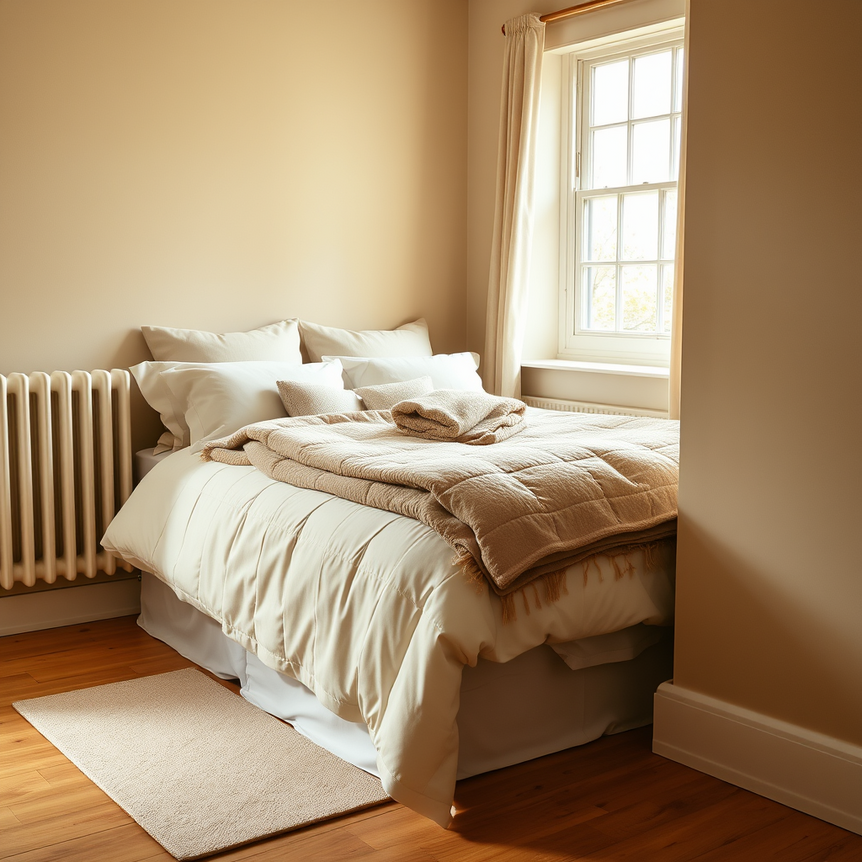Maintaining comfort throughout the year is a common challenge for UK homeowners, where seasonal temperature swings and varying central heating habits can cause discomfort in the living and sleeping environment. During colder months, houses often feel drafty or inefficiently warm despite running central heating systems, while in warmer periods, overheating or reliance on bulky heavy bedding can impact restful sleep. Heavyweight blankets have emerged as an effective warmth solution, offering an adaptable layer of insulation that complements central heating by retaining body heat without causing excessive temperature spikes.
Typical Temperature Settings in UK Homes with Central Heating
UK homes typically maintain indoor temperatures between 18°C to 22°C during winter, following recommendations from the UK’s Energy Saving Trust. Most central heating systems operate within this thermostat range, adjusted according to personal comfort and energy usage. During summer months, heating is usually switched off or set low, resulting in indoor temperatures that fluctuate more widely, often dropping to 15°C or below at night. These temperature variations require bedding solutions that can balance warmth and breathability, adapting to both heating cycles and ambient climate shifts.
The Insulating Science Behind Heavyweight Blankets
Heavyweight blankets retain heat primarily through increased density and the use of insulating materials such as cotton blends, wool, or polyester fibres. The extra weight creates gentle pressure, which reduces heat loss by limiting air gaps between the blanket and the skin—a concept sometimes likened to the benefits of weighted blankets used for relaxation. These blankets trap warm air close to the body more effectively than standard lightweight throws, enhancing thermal retention to keep the user cosy without constant reliance on heating. Their multi-layered construction often combines breathable fabrics with heat-locking fibres, providing warmth paired with moisture management to maintain comfort.
Balancing Warmth: Heavyweight Blankets Versus Central Heating Effects
When using heavyweight blankets alongside central heating, it is important to balance their combined effects to avoid overheating. Excessive warmth during sleep can lead to discomfort, night sweating, and disrupted sleep cycles. Heavyweight blankets supplement heating by maintaining closeness of warmth, enabling homeowners to lower thermostat settings or shorten heating durations while staying warm. However, too high a room temperature combined with heavyweight bedding can result in a climate that feels stifling rather than comfortable. Understanding this interaction allows for strategic control of both heating and bedding to achieve optimal rest conditions.
Practical Strategies to Achieve Year-Round Comfort
To synchronise central heating efficiently with the use of heavyweight blankets, consider lowering the thermostat by 1-2 degrees during colder months. This adjustment compensates for the additional insulation, reducing energy consumption without sacrificing comfort. Use heavyweight blankets primarily during evenings and nighttime when body temperature drops, and switch to lighter layers during daytime or transitional weather. Selecting breathable heavyweight options, such as this 2-Ply Soft King Size Blanket, ensures warmth while preventing overheating.
Exploring All-Season Bedding Alternatives and Layering Techniques
For warmer periods, lightweight blankets made from materials like cotton or linen offer breathability and moisture-wicking properties to maintain freshness. Layering enables adaptable warmth control; for example, combining a lighter blanket with a heavyweight option allows users to add or remove layers according to temperature shifts during the night. This approach mimics professional bedding strategies used in hotels and spas to provide customised comfort and prolong blanket longevity through varied usage.
Professional Insights: Sleep and Interior Experts on Optimizing Comfort
Sleep specialists recommend maintaining bedroom temperatures around 16°C to 19°C for ideal sleep, paired with appropriate bedding to stay warm. They advocate using heavyweight blankets as a supplemental layer that enables lower heating settings, improving sleep quality while reducing energy costs. Interior experts suggest integrating the blanket’s texture and colour into the bedroom design for a soothing atmosphere that enhances relaxation. Combining practical heating adjustments with thoughtfully selected bedding creates a harmonious environment conducive to restorative rest year-round.
Comparison of Bedding and Heating Strategies
| Bedding/Heating Solution | Advantages | Disadvantages | Best Use Case |
|---|---|---|---|
| Heavyweight Blankets | Excellent heat retention, pressure comfort, reduces need for high heating settings | Can cause overheating if room is too warm, heavier to handle | Cold nights, reducing heating bills, improving sleep quality |
| Central Heating at 21-22°C | Comfortable room temperature, no need for extra blankets | Higher energy consumption, potential dry air issues | Daytime or colder spells when blankets are impractical |
| Lightweight Blankets (Cotton, Linen) | Breathable, moisture-wicking, easy to layer | Less insulation, may require supplemental heating | Warmer seasons, transitional weather |
| Layered Bedding | Flexible warmth control, adapts to temperature fluctuations | Requires planning, possible bulkiness | Year-round comfort across seasons |
Embracing Cozy Living: Key Takeaways for Heavyweight Blanket Users
Balancing central heating and heavyweight blanket use can significantly enhance year-round comfort while optimising energy efficiency in UK homes. By lowering thermostat settings and selecting high-quality heavyweight blankets like the 2-Ply Soft King Size Blanket, homeowners can enjoy consistent warmth without overheating. Incorporating layered bedding strategies adapts easily to seasonal shifts, providing a seamless transition from winter chill to summer’s mildness. Embracing these combined solutions supports a cosy, comfortable living environment that meets the unique needs of UK households throughout the year.



